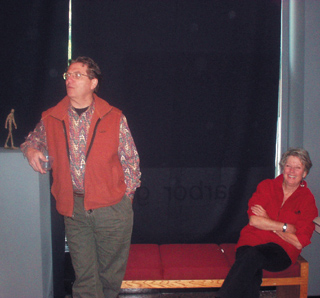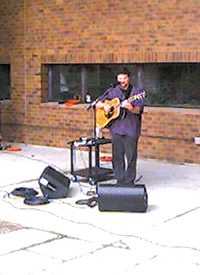The Way of the Warrior: The Military in Art

Artist Ken Hruby and Arts on the Point director Wendy Baring-Gould.
May 22, 2002
It doesn’t take a 5am reveille to be aware of the strains of military tradition that run through the works of Ken Hruby. A veteran of the service and the arts, Hruby has managed to combine two paths through life and consolidate his experiences in much of his artwork that he has displayed. To see his work is to understand the line between duty and doubt.
In the last of the series of Art Talks, sponsored by Arts on the Point, Hruby took the audience through a tour of his work, step by step, using music and visual messaging to communicate the irony that permeates his various sculptures. Hruby has fathered numerous pieces pertaining to the dichotomy between the motivations behind violence and valiance.
Born an army brat himself, Hruby attended West Point and served in command and staff positions with the U.S. military for twenty-one years until he completed his service and enrolled in the School of the Museum of Fine Arts, where he now teaches sculpture. Of his beginning forays into the arts, he says, “I started using abstract forms because they were safe and I didn’t have to do content.”
In one of his works Boys’ Toys, Hruby took weapons confiscated from the Gloucester Police Department and repackaged them as toys, products of the Macho Toyco. For example, in one of the faux toys was a gun and the warning/legal disclaimer on the front warned of damaged hearing while the demolition video label forbade reproduction of the images. The gallows’ humor aspect derives from the obvious overlooking of the danger to others. As the toys grow progressively more dangerous, a system of increasingly valued “Macho Points” allows children to send away for more caustic creations. Not only was it a clever commentary on violence but it also explored the association of the former with masculinity.
With Welcome Home, Let’s Dance, the various misshapen crutches hanging from the ceiling speak of some of the only souvenirs the soldiers ever came back with from their tours of duty, speaking with grim amusement of lost limbs and scars.
Not only a sculptor but a welder, he has also cast some offbeat pieces such as Fun Couple #1 and 2, which are composed of a jockstrap and brassiere in metal.
However, his perspectives on military life have not pleased everyone. He once held a show at his alma mater, West Point. “It was daunting to use icons of military symbology we all had in common. I’d defiled the iconoclasms. Some were openly resentful…it was treated like any other art exhibit, they ignored it. There was virtually no press coverage.” Alternately overlooked and criticized, Hruby even received a message in his gallery sign-in book where he was told to get counseling.
Yet, not all of his art is a monument to unhappy memories or irony. In demonstrating the proud traditions of West Point, one of his pieces dealt with the “bizarre juxtaposition” of the expectations of cadets to be officers and gentlemen. The work shows shoe impressions set up as in dance instruction formation, except the shoes involved are a pair of boot prints done in a filthy cement fondue and a petite parquet set of women’s shoes.
Hruby’s experiences have clearly shaped his creativity in forming pieces that are not quite funny, sad, or disturbing but somehow a combination of the three. In “grappling with the ironies of war,” Hruby details the conundrum of conflict and the paradoxical points he had to deal with as a soldier, civilian, and artist.





















































